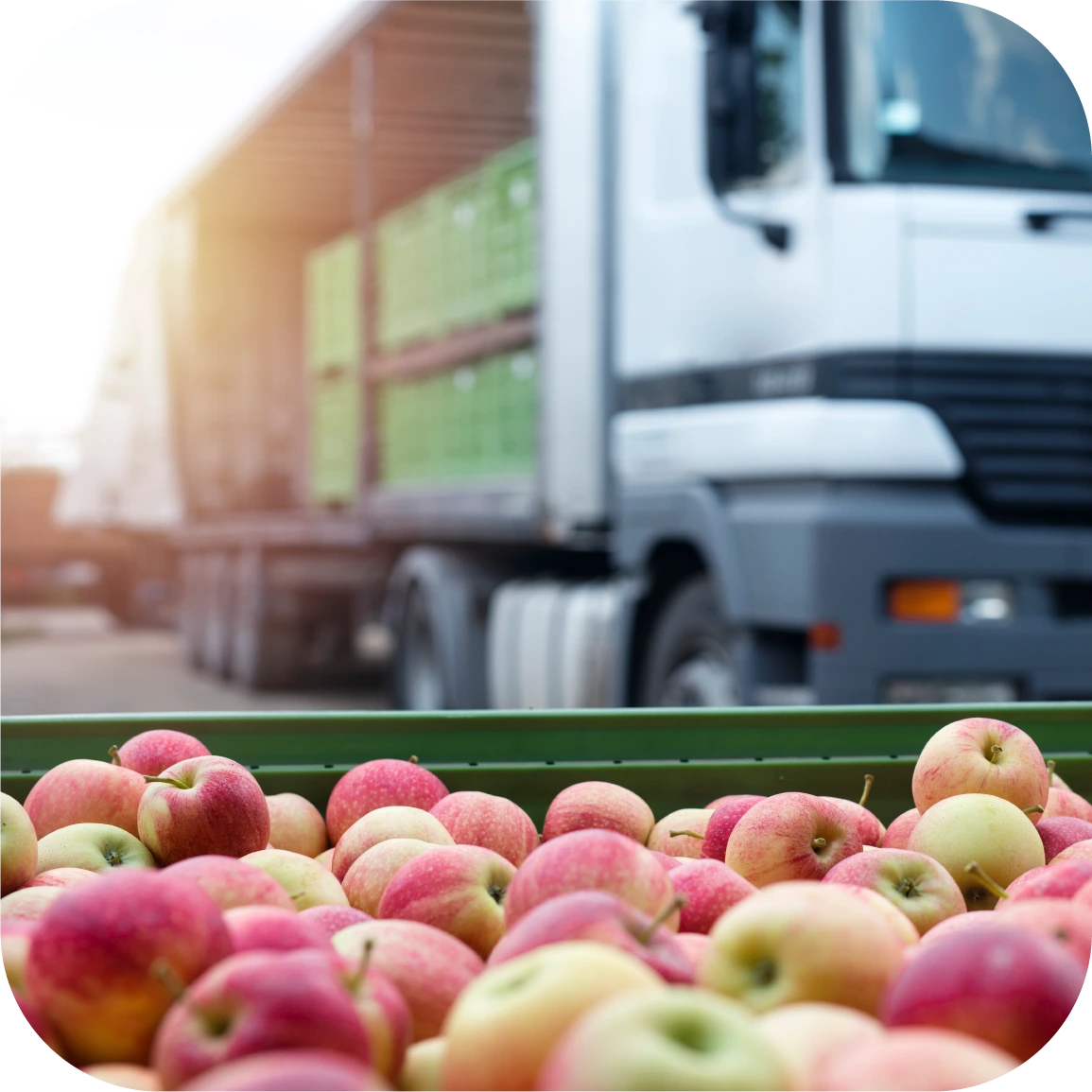Cold chain logistics is a topic that is becoming more important to consider as more regulations are put in place by the FDA and other regulatory bodies. These regulations seek to ensure the safety and quality of temperature-sensitive products by requiring the companies handling those products to monitor and provide records of the temperature that they are held at throughout the process of producing and delivering them to retailers. Sounds simple? It’s not. There are many steps in the cold chain process, as well as many factors that must be considered when making a cold chain management plan. Let’s review all the ins and outs of cold chain logistics to help your company ensure preparedness, compliance, and consistent reputation.
What is Cold Chain Logistics?
Cold chain logistics refers to the transportation and storage of temperature-sensitive goods in a controlled environment. This encompasses everything from food and pharmaceuticals to medical supplies and chemicals – essentially, anything that can spoil or needs to be held at a specific temperature to retain effectiveness. The importance of maintaining proper temperatures during the transportation and storage of these goods cannot be overstated, as any deviation can compromise the integrity and safety of the products. And as one can quickly observe from the provided examples, many of these products are ingested or used for medical purposes, making it all the more important to ensure that the product is helping and not hindering the individual using it.
Cold chain logistics seek to ensure that all of these products remain at the appropriate temperature throughout their entire journey from production to delivery. After all, even a momentary dip in temperature can have disastrous results in terms of creating both waste and safety hazards. It might seem simple to ensure that products are at the correct temperature. Surely you can just check the temperature when you pack and unpack the truck, right? Wrong: not only are there other stages of cold chain logistics outside of transportation, but records need to be able to account for the product’s temperature at every stage of the journey, even when the truck’s in transit. There is always the chance that a trailer’s temperature temporarily fails during the journey for long enough to damage the product, but to come back up to standard temperature by the time the truck is being unpacked. But without monitoring temperatures throughout the entire journey instead of just at the beginning and end, you would never know that the product was destroyed.
Increase Your ROI by Investing in AirFinder Everywhere
- Loss Prevention. Reduce the amount of loss that occurs during the supply chain process
- Location Coverage. AirFinder Everywhere uses a combination of GPS, Cellular, and WiFi to determine location everywhere
- Security Alerts. Know when a delay in shipment has occurred so the problem
can be addressed immediately.
Stages of the Cold Chain Process
The cold chain process is extremely complex and involves many different stages. The primary stages of cold chain logistics include: manufacturing, storage and distribution, transportation, and retail. Here’s a quick overview of these stages and their responsibilities in the cold chain:
- Manufacturing. The product must be produced and packaged in a way that maintains its temperature requirements.
- Storage and Distribution. The product must be stored in appropriate conditions prior to transportation without damaging the packaging.
- Transportation. The product must be moved from the distribution center to the retailer while maintaining the necessary temperature at all times.
- Retail. The product must be stored and then displayed at an acceptable range to ensure its safety and quality for the end user.
Across all of these stages, there are a number of factors that workers must remain aware of at all times. Most of these factors impact multiple stages rather than being contained within just one. Let’s learn a bit more about those aspects of cold chain management.
Aspects of Cold Chain Management
When most people think of the cold chain, they only think about the transportation stage and everything that entails. Although this area does present some of the greatest challenges for cold chain management, it does not constitute the whole of the cold chain. There are other equally important factors that need to be taken into consideration across all stages when trying to understand cold chain logistics and how to effectively monitor your cold chain. There are five factors that need to be considered to fully understand cold chain management.
Preplanning
An often overlooked step of successful cold chain logistics is proper preplanning, which includes selecting the right carrier, understanding shipment requirements, and establishing and maintaining open communication with third parties. When it comes to choosing a carrier, it is crucial to select one that has the expertise and equipment necessary to handle temperature-sensitive goods. Understanding the shipment requirements of a given product, such as the temperature range and where the shipment is going, will also help in selecting the appropriate carrier, as well as in making decisions about preparing the products for transport. Throughout this process, it is important to maintain open communication with participants at all stages of the cold chain process to ensure that requirements are understood and can be properly fulfilled. Essentially, by reviewing everything beforehand, you are able to set yourself up for success and a less stressful process overall.
Packaging
Choosing the right packaging materials is an equally critical – and equally overlooked – aspect of cold chain management. This might be considered a subset of preplanning, but packaging is important enough to be treated as a factor of cold chain logistics in its own right. After all, if a product’s packaging cannot withstand temperature changes and provide adequate insulation, that product will undergo damage. Proper labeling is also essential to ensure that the carriers and handlers understand the requirements and proper handling of the products; further, packaging must be durable enough to withstand the stressors associated with transportation.
Transportation
As we’ve already alluded to, transportation is the aspect that most people think of first when they think of cold chain logistics. It’s fairly simple to explain this factor. Essentially, during the transportation of temperature-sensitive products, their safety and quality are maintained through continuous temperature monitoring and environmental control. Carriers must have the necessary equipment to monitor and control the temperature of the shipment. Refrigerated trucks help maintain the temperature of the product; real-time condition monitoring tags and sensors provide temperature visibility so drivers can respond to any unexpected deviations that might occur while they’re on the road. Proper loading and unloading procedures must also be followed to avoid temperature fluctuations at the end point.
Storage
Storage is another essential aspect to maintaining the temperature of products. Temperature-controlled warehouses and storage facilities are used to avoid temperature fluctuations, both before transportation and after. In some cases, the base materials used to produce the final product are also temperature-sensitive, and thus must be similarly stored before they enter the production process. Inventory management is crucial at this juncture, as leaving products in storage for extended periods can compromise their integrity. Many of the organizations that purchase and distribute temperature-sensitive goods will have appropriate storage on their premises; it’s just a matter of getting them there and unloading properly.
Compliance
Cold chain management does not, however, stop at the physical process of creating, transporting, and storing temperature-sensitive goods. It also consists of being able to provide records and proof of compliance for the organizations that monitor the safety of these products. Regulatory requirements set forth by the FDA and other governing bodies must be proven with reliable documentation and record-keeping. Without a system in place, a company risks losing their ability to operate over an issue of traceability and accountability. Compliance also dictates that employees and handlers must be trained and educated in the proper procedures for handling these products, in order to assure that everyone knows what they’re doing.
Addressing Common Cold Chain Challenges
Maintaining awareness of all of these stages and aspects of the cold chain helps companies ensure effective cold chain management strategies. But the fact of the matter is that cold chain logistics wouldn’t be such a hot topic if there weren’t common challenges that need to be addressed. After all, a smooth process can simply run and be improved upon; one with many moving parts is bound to need a lot more attention no matter how hard you work to refine it. So what are the inherent challenges that need to be carefully considered at all stages of cold chain management?
Temperature Control
Let’s begin with the obvious: temperature control is the most important aspect of cold chain logistics, but controlling temperature is not easy. We’ve already established that there are many stages of cold chain logistics; temperature must be maintained throughout each of these. Different products might require different temperatures, making it dangerous to ship them together. Different trailers and freezers might operate at different standard settings, requiring adjustments depending on what they’re hauling. And that’s before you have to consider how transferring products between trailers or freezers can cause temperature change if you take too long or if something is wrong with the packaging. It’s important to understand every step on the journey that a product is taking so you can prepare for each – that’s why preplanning is considered one of the most important factors, because controlling a product’s temperature is difficult even if you do manage to retain full visibility and continuous monitoring.
Process Complexity
Another challenge with monitoring the cold chain is the sheer complexity of the process. Think about it – we discussed how many steps it consists of, as well as a number of individual factors that workers are expected to remain aware of at all times. It’s not an easy job to keep track of all that, and that’s before you start considering how many times a product will change hands before it reaches its final destination. Admittedly, the logistics of getting any product from the manufacturer to the retailer can pose quite the challenge, but when you add in the need for temperature control, the complexity increases significantly. Every step in the cold chain process must be carefully managed to ensure that the product is not exposed to temperatures outside of its acceptable range, and each person involved in the process must fully understand what is going on at all times. There’s very little room for error, so you need to make sure that you are able to visualize, analyze, and understand the process as a whole as well as the individual steps contained therein.
Identifying Failure
Identifying when failure occurs is a major hurdle for cold chain logistics management. There are all sorts of unexpected failures that can occur over the incredibly complex process of transporting temperature-sensitive goods. Temperature can fluctuate due to equipment malfunctions, power outages, improper handling, transportation delays, or even inadequate or damaged packaging. While you can try to prevent these scenarios from happening altogether, there’s no guarantee that the worst case scenario won’t come to pass. Even worse: there’s no guarantee that you’ll even know that it happened. Depending on where in the process the fluctuation occurs or how long it lasts, you might not ever be the wiser. A product might regain its lost temperature by the time it makes it to the end of the process. By then, however, it’s a moot point – if it dipped below the proper temperature for long enough, it has likely been compromised. It’s important to ensure that you have eyes on a product's temperature at every single moment, that way you can identify failures immediately in order to remedy them or at least save yourself from delivering damaged goods.
Proving Compliance
As previously addressed, compliance is an often overlooked aspect of cold chain logistics. Not the fact that one’s cold chain must be compliant, but rather the fact that compliance must be provable and documentation must be available when it is requested. If this paperwork cannot be provided, compliance is a moot point because there are no records to back it up. Proving compliance can be difficult due to the fact that the cold chain has so many seemingly independent parts operating within it. Manufacturers, trucking companies, and any end customers or storage units are all beholden to compliance. It’s important to either have a system in place that accounts for each step, as well as the unique requirements for different types of cold chain compliance, or to facilitate ease of transfer between systems if these components operate independently and have their own equipment to use.
How to Monitor Your Cold Chain
What does monitoring your cold chain look like? How can you retain awareness of your products at every single stage, from production to arrival at your customer’s door? The best way to demonstrate what this crucial cold chain logistics process could – and, admittedly, should – look like is through a hypothetical scenario.
Let’s say that your company manufactures and delivers temperature-sensitive pharmaceuticals. Since fluctuating temperatures in these products can result in ineffective medications at best, deadly medications at worst, it is especially important to ensure that they maintain the ideal temperature at all stages. Within the plant itself, you’ve been able to effectively maintain temperatures, but there’s been some issues with products being damaged during transport even though you’ve been keeping your trailers at the same internal temperature as always. How can you know what the product temperature dips so you can address the challenges as they arise, find out what’s wrong, and stop losing money and reputation from damaged products?
By using a cold chain solution for temperature monitoring, your company can attach individual tags with temperature sensors to different products or pallets. You can also configure these tags to alert you when the temperature starts to move out of the acceptable range. By doing so, you’re able to check on any fluctuations as they occur rather than only when you stop. Also, these systems can be configured to back up the data recorded from the sensors, allowing you to utilize the information for proof of compliance if a regulatory body ever makes inquiries.
Cold Chain Management with Link Labs
Link Labs’ AirFinder system has all the capabilities discussed in the scenario above. We can help you stay alert to shifts in temperature from your product, maintain visibility across all stages of the cold chain, and provide the data necessary to prove compliance. We understand the importance of delivering a quality product and meeting regulations, and we work every single day to continue improving our already award-winning system to better serve our customers and their cold chain needs. To learn more about our cold chain monitoring system and how it can work for you, book a demo today!





